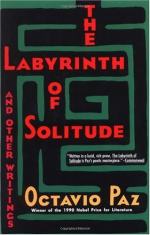
|
| Name: _________________________ | Period: ___________________ |
This test consists of 5 multiple choice questions, 5 short answer questions, and 10 short essay questions.
Multiple Choice Questions
1. Paz says that during critical moments in a nation's development, the people ask themselves a critical question. What is that question?
(a) How can we move forward?
(b) Who are we and how can we fulfill this obligation?
(c) How do we want the future to look?
(d) Who should lead us?
2. According to Paz, what is death in modern thought?
(a) The avoidable end to a wasted life.
(b) The end of all unworthy men.
(c) The putting to rest of all sorrow.
(d) The predictable end to a natural progression.
3. Why does a Mexican blend into his surroundings and become solely Appearance?
(a) He wants to end his individuality.
(b) He loves appearance.
(c) He fears appearances.
(d) He fears human interaction.
4. What analogy does Paz use to explain Mexico's history?
(a) A man searching for his parents.
(b) A child without a family.
(c) A man searching for his wife.
(d) A child without a future.
5. What makes the foreigner skeptical about Mexicans (Chapter Four)?
(a) Their indiscriminate money spending for fiestas.
(b) Their poor economy.
(c) Their unforeseen violence and cult of death.
(d) Their lavish festivals.
Short Answer Questions
1. In Paz's estimation, what vital word has the Mexican forgotten?
2. Why are woman considered inferior people?
3. How does Paz differentiate between views of the body in Mexico and North America?
4. According to Paz, what does it mean when a person is alone?
5. What role does the Mexican man play in society?
Short Essay Questions
1. What group of people did the author have in mind as he wrote the book? How and why did those people become important to him?
2. What is the Mexican's ideal of manliness? How does it affect his interactions with other people?
3. What is the modern view of death? How is it dramatically different from the Aztec view?
4. What mutual problem do both the Mexican and the North American face? What is the solution to that problem?
5. What were Paz's impressions of the United States? How does that contrast with the literature being written? In your mind, what accounts for the discrepancy?
6. What is left of the colonial world? Are those remnants the best or the worst parts that could be left behind?
7. In the author's parable, who is Nobody? Is it possible for Nobody to break the progression of his existence? Why or why not?
8. What is Paz's understanding of woman? How does it fit the Mexican mindset?
9. In Chapter Three, the following idea is presented: "There is nothing so joyous as a Mexican fiesta, but there is also nothing so sorrowful. Fiesta night is also a night of mourning" (Chapter 3, page 53). What does that mean?
10. What is the character of the Mexican's solitude? How does it differ from the solitude of the North American?
|
This section contains 1,785 words (approx. 6 pages at 300 words per page) |

|




